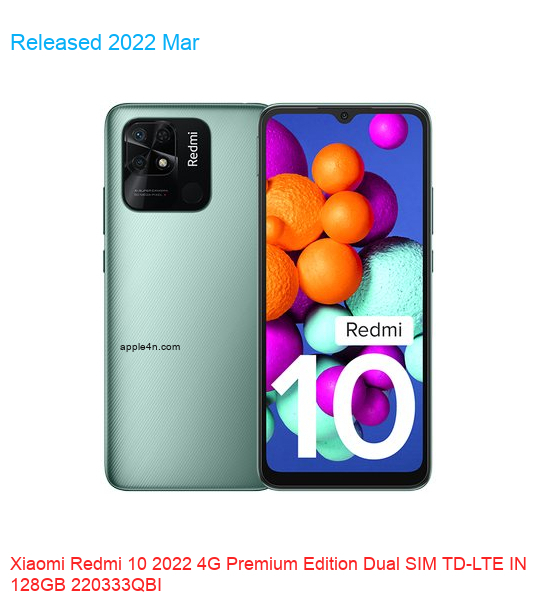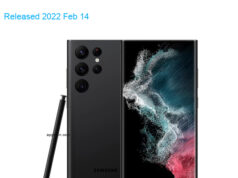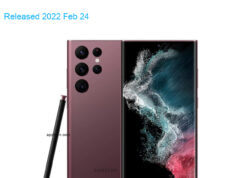| Brand | Xiaomi |
| Model | Redmi 10 2022 4G Premium Edition Dual SIM TD-LTE IN 128GB 220333QBI |
| Released | 2022 Mar |
| Announced | 2022 Mar 20 |
| Hardware Designer | Xiaomi |
| Manufacturer | Foxconn |
| Codename | Xiaomi Fog B |
| General Extras | Haptic touch feedback |
| Device Category | Smartphone |
| Width | 76.56 mm |
| Height | 169.59 mm |
| Depth | 9.13 mm |
| Dimensions | 3.01×6.68×0.36 inches |
| Mass | 203 g |
| Platform | Android |
| Operating System | Google Android 11 (R) |
| Software Extras | Voice Command , Business card recognition , Navigation software , Augmented Reality (AR) , Intelligent personal assistant , Voice Recognition , Face Recognition |
| CPU Clock | 2400 MHz |
| CPU | Qualcomm Snapdragon 680 SM6225, 2021, 64 bit, octa-core, 6 nm, Qualcomm Adreno 610 GPU |
| RAM Type | LPDDR4x SDRAM |
| RAM Capacity (converted) | 6 GiB RAM |
| Non-volatile Memory Interface | UFS 2.2 |
| Non-volatile Memory Capacity (converted) | 128 GB ROM |
| Display Notch | 1-notch |
| Display Diagonal | 170.4 mm |
| Resolution | 720×1650 |
| Horizontal Full Bezel Width | 8.41 mm |
| Display Area Utilization | 82.0% |
| Pixel Density | 268 PPI |
| Display Type | Color IPS TFT LCD display |
| Number of Display Scales | 16.8M |
| Display Refresh Rate | 60 Hz |
| Scratch Resistant Screen | Gorilla Glass 3 |
| Graphical Controller | Qualcomm Adreno 610 |
| GPU Clock: | 1000 MHz |
| A/V Out | No |
| Microphone(s) | stereo |
| Loudspeaker(s): | mono |
| Audio Output: | 3.5mm |
| Supported Cellular Bands | GSM850 , GSM900 , GSM1800 , GSM1900 , UMTS2100 (B1) , UMTS850 (B5) , UMTS900 (B8) , LTE2100 (B1) , LTE1800 (B3) , LTE850 (B5) , LTE900 (B8) , TD-LTE2300 (B40) , TD-LTE2500 (B41) bands |
| Supported Cellular Data Links | GPRS , GPRS MSC33 , EDGE , UMTS , HSUPA , HSUPA 5.8 , HSDPA , HSPA+ 21.1 , HSPA+ 42.2 , DC-HSDPA 42.2 , LTE , LTE 100/50 , LTE 150/50 , LTE 300/50 , LTE 600/50 data links |
| SIM Card Slot | Nano-SIM (4FF) |
| Complementary Phone Services | Voice transmission , Voice speaker , Vibrate , Speakerphone , ANC , HD Voice , VoLTE , ViLTE |
| SAR (head) | 0.769 W/kg |
| SAR (body) | 0.736 W/kg |
| Dual Cellular Network Operation | Dual standby |
| Sec. Supported Cellular Networks: | GSM850 , GSM900 , GSM1800 , GSM1900 , UMTS2100 (B1) , UMTS850 (B5) , UMTS900 (B8) , LTE2100 (B1) , LTE1800 (B3) , LTE850 (B5) , LTE900 (B8) , TD-LTE2300 (B40) , TD-LTE2500 (B41) |
| Sec. Supported Cellular Data Links: | GPRS , GPRS MSC33 , EDGE , UMTS , HSUPA , HSUPA 5.8 , HSDPA , HSPA+ 42.2 , DC-HSDPA 42.2 , LTE , LTE 100/50 , LTE 150/50 , LTE 300/50 , LTE 600/50 |
| Sec. SIM Card Slot | Nano-SIM (4FF) |
| Touchscreen Type | Capacitive multi-touch screen |
| Expansion Interfaces | TransFlash , microSD , microSDHC , microSDXC |
| USB | USB 2.0 |
| USB Services | USB charging , USB fast charging , USB Host , USB OTG 1.3 , USB OTG 2.0 , USB PD , USB PD 2.0 , USB PD 3.0 |
| USB Connector | USB C reversible |
| Max. Charging Power | 18.0 W |
| Bluetooth | Bluetooth 5.0 |
| Wireless LAN | 802.11a , 802.11b , 802.11g , 802.11n , 802.11ac |
| Wireless Services | Miracast , Wi-Fi Direct , Wi-Fi Tethering , WiDi , Wi-Fi Calling |
| FM Radio Receiver | FM radio (76-108 MHz) with RDS |
| Complementary Satellite Services | Simultaneous GPS , A-GPS , Geotagging , QuickGPS |
| Supported GLONASS protocol(s) | L1OF |
| Supported Galileo service(s) | E1 |
| Supported BeiDou system (BDS) | B1I BeiDou receiver |
| Camera Placement | Rear |
| Camera Image Sensor | BSI CMOS |
| Number of effective pixels | 50.3 MP camera |
| Aperture (W) | f/1.80 |
| Zoom | 1.0 x optical zoom |
| Focus | PD AF |
| Video Recording | 1920×1080 pixel |
| Flash | single LED |
| Camera Extra Functions | Pixel unification , HDR photo , HDR video , Red-eye reduction , Slow motion video , Burst mode , Refocus , Touch focus , Macro mode , Panorama Photo , Face detection , Face tagging , Smile detection , Face retouch , Face retouch (video) , Intelligent scene detection |
| Aux. Camera Image Sensor | Mono CMOS |
| Aux. Camera Number of Pixels | 1.9 MP aux. cam |
| Aux. Camera Aperture (W) | f/2.20 |
| Aux. 2 Camera Image Sensor | No |
| Aux. 3 Camera Image Sensor | No |
| Aux. 4 Camera Image Sensor | No |
| Secondary Camera Placement | Front |
| Secondary Camera Sensor | BSI CMOS |
| Secondary Camera Number of pixels | 4.9 MP sec. cam |
| Secondary Aperture (W) | f/2.20 |
| Secondary Video Recording | 1920×1080 pixel |
| Secondary Camera Extra Functions | HDR photo , HDR video , Slow motion video , Burst mode , Panorama Photo , Face detection , Face tagging , Smile detection , Face retouch , Face retouch (video) , Intelligent scene detection |
| Sec. Aux. Cam. Image Sensor | No |
| Built-in compass | Yes |
| Built-in accelerometer | 3D accelerometer |
| Built-in gyroscope | Yes |
| Additional sensors | Barometer , FP sensor , Hall , L sensor , P sensor |
| Protection from solid materials | Yes |
| Protection from liquids | Yes |
| Battery | Li-ion polymer (LiPo) |
| Nominal Battery Voltage | 3.87 Volts |
| Nominal Battery Capacity | 6000 mAh battery |
| Nominal Battery Energy | 23.22 Wh |
| Talk Time: | 34.0 hours |
| Market Countries | India |
| Market Regions | Asia |
| Price | 203.99 USD |
| Added | 2025-03-06 |
Specifications data description of this 📱Xiaomi Redmi 10 2022 4G Premium Edition Dual SIM TD-LTE IN 128GB 220333QBI📱
Title: Xiaomi Redmi 10 2022 4G Premium Edition Dual SIM TD-LTE IN 128GB 220333QBI: A Comprehensive Specification Overview
Introduction:
Xiaomi, a leading smartphone manufacturer, has launched the Redmi 10 2022 4G Premium Edition Dual SIM TD-LTE IN 128GB 220333QBI, a powerful and feature-rich device that promises to deliver an exceptional user experience. In this blog post, we will take a closer look at the specifications of this device, including its network, launch date, body, display, operating system, chipset, CPU, GPU, memory, camera, sound, comms, features, and battery.
Lineup:
The Xiaomi Redmi 10 2022 is part of the Redmi lineup, which is known for its affordability and high-quality features. The Premium Edition of this device comes with a dual SIM TD-LTE IN 128GB 220333QBI, making it an ideal choice for users who require multiple SIM cards and a large storage capacity.
Design:
The Xiaomi Redmi 10 2022 has a sleek and stylish design, with a premium finish that gives it a sophisticated look. The device is lightweight and comfortable to hold, making it perfect for everyday use.
Specifications:
🌐 NETWORK:
The Xiaomi Redmi 10 2022 supports dual SIM TD-LTE IN 128GB 220333QBI, providing users with fast and reliable connectivity.
📅 LAUNCH:
The Xiaomi Redmi 10 2022 was launched in 2022, making it a relatively new device in the market.
🏋️ BODY:
The Xiaomi Redmi 10 2022 has a dimensions of 163.6 x 75.4 x 9.1 mm and weight of 192 g, making it lightweight and easy to carry around.
🌈 DISPLAY:
The device features a 6.5-inch IPS LCD display with a resolution of 1080 x 2400 pixels and a pixel density of 405 ppi. The display is bright, clear, and offers a wide viewing angle, making it perfect for watching videos and playing games.
🤖 OS 🛠️:
The Xiaomi Redmi 10 2022 runs on the latest version of MIUI, which is based on Android 11. This operating system is fast, smooth, and offers a wide range of features and customization options.
🚀 Chipset 🔧:
The device is powered by the MediaTek Helio G88 chipset, which is known for its high performance and power efficiency.
💪 CPU 🖥️:
The Xiaomi Redmi 10 2022 features an octa-core CPU with two Cortex-A75 cores clocked at 2.0 GHz and six Cortex-A55 cores clocked at 1.8 GHz. This powerful CPU ensures smooth and fast performance, even when running multiple applications simultaneously.
🎮 GPU 💻:
The device features a Mali-G52 MC2 GPU, which offers excellent graphics performance, making it perfect for gaming and multimedia applications.
🧠 MEMORY 🗂️:
The Xiaomi Redmi 10 2022 comes with 4GB of RAM and 128GB of internal storage. This memory configuration ensures fast and smooth performance, even when running multiple applications simultaneously.
📷 CAMERA 🎥:
The device features a dual-camera setup on the back, with a 50MP primary camera and a 2MP depth sensor. The front camera has an 8MP resolution, making it perfect for selfies and video calls.
🔈 SOUND 🎵:
The Xiaomi Redmi 10 2022 features a high-quality sound system, with loud and clear speakers that offer an immersive audio experience.
📡 COMMS 📶:
The device supports dual-band Wi-Fi (2.4 GHz and 5 GHz), Bluetooth 5.0, GPS, and Infrared, providing users with fast and reliable connectivity options.
💡 FEATURES 🎁:
The Xiaomi Redmi 10 2022 comes with a range of features, including a side-mounted fingerprint sensor, face unlock, and a 3.5mm headphone jack.
🔋 BATTERY🔌:
The device features a large 5000mAh battery, which provides long-lasting battery life, even with heavy use.
Conclusion:
The Xiaomi Redmi 10 2022 4G Premium Edition Dual SIM TD-LTE IN 128GB 220333QBI is a powerful and feature-rich device that offers excellent value for money. With its high-performance chipset, fast and reliable network connectivity, large storage capacity, and long-lasting battery, this device is an ideal choice for users who require a reliable and versatile smartphone. We invite readers to leave a comment and share their thoughts on this device.








